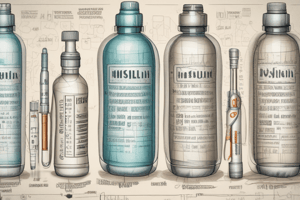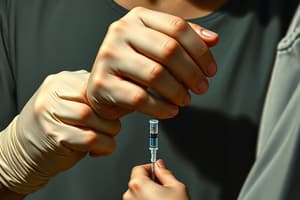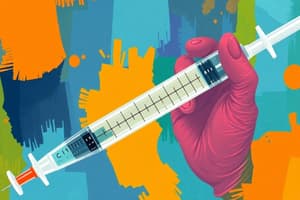Podcast
Questions and Answers
Which of the following injection sites is generally preferred for insulin administration?
Which of the following injection sites is generally preferred for insulin administration?
- Abdomen (correct)
- Anterior thigh
- Hips
- Posterior arm
What is the primary reason for rotating insulin injection sites?
What is the primary reason for rotating insulin injection sites?
- To prevent lipodystrophy and erratic insulin absorption. (correct)
- To minimize pain during injection.
- To improve insulin absorption rate.
- To prevent infection at the injection site.
What needle gauge range is appropriate for administering insulin injections?
What needle gauge range is appropriate for administering insulin injections?
- 22 - 25 gauge
- 30 - 32 gauge
- 18 - 20 gauge
- 27 - 29 gauge (correct)
Why is it recommended to roll an insulin vial between the palms of the hands before preparation?
Why is it recommended to roll an insulin vial between the palms of the hands before preparation?
Why should an insulin vial NOT be shaken?
Why should an insulin vial NOT be shaken?
When mixing insulins, which type should be drawn into the syringe first?
When mixing insulins, which type should be drawn into the syringe first?
Which insulins are typically NOT compatible for mixing with other types of insulin?
Which insulins are typically NOT compatible for mixing with other types of insulin?
At what angle should insulin be injected subcutaneously for a client with a normal amount of subcutaneous tissue?
At what angle should insulin be injected subcutaneously for a client with a normal amount of subcutaneous tissue?
Which types of insulin can be administered intravenously?
Which types of insulin can be administered intravenously?
Which of the following is a potential side effect of pramlintide, an amylinomimetic medication?
Which of the following is a potential side effect of pramlintide, an amylinomimetic medication?
Which of the following is a potential side effect of growth hormone therapy?
Which of the following is a potential side effect of growth hormone therapy?
A patient taking antidiuretic hormones for diabetes insipidus should be monitored for which complication?
A patient taking antidiuretic hormones for diabetes insipidus should be monitored for which complication?
When administering levothyroxine, what is a crucial instruction to provide to the patient?
When administering levothyroxine, what is a crucial instruction to provide to the patient?
Which of the following foods should be consumed in moderation by a patient with hyperthyroidism?
Which of the following foods should be consumed in moderation by a patient with hyperthyroidism?
A patient taking propylthiouracil (PTU) should be closely monitored for:
A patient taking propylthiouracil (PTU) should be closely monitored for:
What is the primary function of calcitonin in regulating calcium levels?
What is the primary function of calcitonin in regulating calcium levels?
A patient with Addison's disease taking fludrocortisone acetate should be educated on the signs and symptoms of:
A patient with Addison's disease taking fludrocortisone acetate should be educated on the signs and symptoms of:
Which of the following electrolyte imbalances is a potential side effect of glucocorticoid therapy?
Which of the following electrolyte imbalances is a potential side effect of glucocorticoid therapy?
Why is it essential not to stop steroid medications abruptly?
Why is it essential not to stop steroid medications abruptly?
A male patient taking methyltestosterone should be monitored for:
A male patient taking methyltestosterone should be monitored for:
A patient is prescribed insulin lispro (Humalog). When should this type of insulin be administered?
A patient is prescribed insulin lispro (Humalog). When should this type of insulin be administered?
Which type of insulin has a duration of action that lasts for approximately 20-24 hours?
Which type of insulin has a duration of action that lasts for approximately 20-24 hours?
A patient taking NPH insulin (Humulin N) should be taught that the peak effect of this medication occurs in approximately:
A patient taking NPH insulin (Humulin N) should be taught that the peak effect of this medication occurs in approximately:
Why is it important to know the peak times of insulin medications?
Why is it important to know the peak times of insulin medications?
A patient is prescribed a mixed insulin (Humulin 70/30). What is a key instruction for administering this type of insulin?
A patient is prescribed a mixed insulin (Humulin 70/30). What is a key instruction for administering this type of insulin?
Flashcards
Insulin Injection Sites
Insulin Injection Sites
Preferred sites include the abdomen, posterior arm, anterior thigh, and hips.
Rotate Injection Sites
Rotate Injection Sites
Changing injection spots prevents lipodystrophy and erratic insulin absorption.
Needle Gauge
Needle Gauge
For insulin injections, use a 27-29 gauge needle, typically 1/2 inch long.
Drawing Insulin
Drawing Insulin
Signup and view all the flashcards
Aspiration in Insulin Injection
Aspiration in Insulin Injection
Signup and view all the flashcards
Dawn Phenomenon
Dawn Phenomenon
Signup and view all the flashcards
Somogyi Phenomenon
Somogyi Phenomenon
Signup and view all the flashcards
GLP-1 Receptor Agonists
GLP-1 Receptor Agonists
Signup and view all the flashcards
SGLT2 Inhibitors
SGLT2 Inhibitors
Signup and view all the flashcards
Inhaled Insulin
Inhaled Insulin
Signup and view all the flashcards
Growth Hormones
Growth Hormones
Signup and view all the flashcards
Growth Hormone Receptor Antagonist
Growth Hormone Receptor Antagonist
Signup and view all the flashcards
Antidiuretic Hormones
Antidiuretic Hormones
Signup and view all the flashcards
Hypothyroidism Drugs
Hypothyroidism Drugs
Signup and view all the flashcards
Signs of Hyperthyroidism
Signs of Hyperthyroidism
Signup and view all the flashcards
Hyperparathyroidism Drugs
Hyperparathyroidism Drugs
Signup and view all the flashcards
Vitamin D Function
Vitamin D Function
Signup and view all the flashcards
Corticosteroids
Corticosteroids
Signup and view all the flashcards
Side Effects of Glucocorticoids
Side Effects of Glucocorticoids
Signup and view all the flashcards
Rapid Acting Insulin
Rapid Acting Insulin
Signup and view all the flashcards
Short Acting Insulin
Short Acting Insulin
Signup and view all the flashcards
Long Acting Insulin
Long Acting Insulin
Signup and view all the flashcards
Insulin Mixing
Insulin Mixing
Signup and view all the flashcards
Insulin Peak Times
Insulin Peak Times
Signup and view all the flashcards
Insulin Administration
Insulin Administration
Signup and view all the flashcards
Study Notes
Endocrine System Drugs
- Various types of drugs are used to treat disorders related to the endocrine system.
- Specific drugs are categorized based on the target gland.
Drugs for Pituitary Disorders
-
Growth Hormones: These treat growth hormone deficiencies.
- Examples: mecasermin, somatropin
- Side effects can include headache, vomiting, fatigue, and muscle pain.
-
Growth Hormone Receptor Antagonist: These treat acromegaly.
- Examples: Pegvisomant, Octerotide
- Side effects include diarrhea, nausea, and blurred vision.
Antidiuretic Hormones
- These treat diabetes insipidus.
- Examples: Vasopressin, Desmopressin acetate
- Side effects: water intoxication, and hypertension
- Interventions include monitoring weight, intake, and output.
Drugs for Thyroid Disorders
-
Hypothyroidism: Levothyroxine
- Side effects: signs of hyperthyroidism
- Interventions: Monitor T3, T4, and TSH levels; take drug in the morning 30-60 minutes before meals; monitor pulse rate.
-
Hyperthyroidism:
- Drugs: Propylthiouracil (PTU), Methimazole, Potassium iodide, Iodine solution (Lugol's Solution) Iodine 131
- Side effects: Signs of hypothyroidism.
- Interventions: Monitor T3, T4 & TSH levels; Monitor weight; Take with meals
Foods that Block Thyroid Gland Function
- Cruciferous vegetables, Cauliflower, Cabbage, Turnips, Strawberries, Peaches, Spinach, Kale, Brussels sprouts, Radish and Peas
PTU
- Causes agranulocytosis.
- Monitor for fever and sore throat.
- Check CBC with differential for neutropenia.
Parathyroid Drugs
-
Vitamin D Supplements: Ergocalciferol (Vit. D₂), Cholecalciferol (Vit. D₃)
- Side effect: Hypervitaminosis D
-
Bisphosphonates and Calcium Regulating Drugs: Alendronate, Calcitonin salmon, Zoledronate, Risedronate sodium, Ibandronate, Etidronate disodium
- Side effects: Stomach pain, Constipation, Diarrhea, Flatulence, nausea
-
Oral Calcium Supplements: Calcium carbonate (Tums), Calcium acetate
- Side effect: Gastric upset
Hyperparathyroidism and Hypercalcemia Drugs
- Drugs: Gallium nitrate, Cinacalcet hydrochloride, Paricalcitol, Doxercalciferol
- Side effects: Nausea, Vomiting, and Diarrhea
- Interventions: Foods rich in Calcium
Vitamin D and Calcitonin Function
- Vitamin D: Enhances absorption of calcium in the gastrointestinal tract.
- Calcitonin: Decreases serum calcium and inhibits bone breakdown.
Mineralocorticoids
- Fludrocortisone Acetate: Replaces hormones in Addison's disease.
- Side effects: Signs of Cushing's syndrome, Gastrointestinal bleeding
- Interventions: Take drugs with food or milk; High potassium diet
Glucocorticoids
- Function: Fights inflammation, Treats allergy, Helps cope with stress.
- Examples: Dexamethasone, Prednisone, Hydrocortisone
- Side Effects: Cushing's syndrome, Hypernatremia, Hypokalemia, Hyperglycemia, Osteoporosis, Weight gain, Mood swings, Cataracts, Acne
- Interventions: Monitor blood sugar, High potassium diet, Monitor for gastrointestinal bleeding; Take drug in the morning
Androgens
- Methyltestosterone: Replaces androgen hormones, treats certain types of breast cancers, Risk for prostate cancer
- Side Effects: Masculinization, Priapism, Acne
- Interventions: Menstrual irregularities, Changes in libido, take with food or snacks.
Steroid Drugs
- Should not be stopped abruptly
- Takes time for adrenal gland to produce its own steroids
- Dose must be tapered to prevent a fatal adrenal crisis
Drugs for Diabetes Mellitus
-
Rapid Acting Insulin:
- Clear
- Other Names: Insulin aspart (NovoLog), Insulin glulisine (Apidra), Insulin lispro (Humalog)
- Onset → 15 minutes
- Peak → 30 – 90 minutes
- Duration → 3 – 5 hours
- Implications: Given immediately before meals, Given SQ or IV, May mix with NPH insulin
-
Short Acting Insulin:
- Clear
- Other Names: Insulin regular (Humulin R, Novolin R)
- Onset → 30 – 60 minutes
- Peak → 2 – 4 hours
- Duration → 5 – 8 hours
- Implications: Given 30 minutes before meals; given SQ or IV; May mix with NPH insulin
-
Intermediate Acting Insulin:
- Cloudy
- Other Names: Insulin NPH human (Humulin N, Novolin N)
- Onset → 1 – 3 hours
- Peak → 8 hours
- Duration → 12 – 16 hours
- Implications: Lowers blood glucose elevations when RA insulins stop working; Given SQ; May mix with RA or SA insulin
-
Long Acting Insulin:
- Clear
- Other Names: Insulin glargine (Lantus, Toujeo), Insulin detemir (Levemir)
- Onset → 1 hour
- Peak → Lantus - NO PEAK, Levemir - 6 – 8 hours
- Duration → 20 – 24 hours
- Implications: Lowers blood glucose elevations when RA insulins stop working; Given SQ; Usually taken once a day; May mix with RA or SA insulin
-
Mixed Insulin:
- Cloudy
- Other Names: Humulin 70/30, novolin 70/30, Relion 70/30
- Onset → 30 minutes
- Peak → 2 – 12 hours
- Duration → 24 hours
- Implications: Usually taken once daily; Given SQ; Do not mix with other insulins
Insulin Injection Tips
- Know peak times of insulin medications (period where clients most likely develop hypoglycemic or insulin reactions).
- Rotate injection sites (to prevent lipodystrophy, erratic insulin absorption).
Insulin FAQs
- Insulin is not given orally because it is destroyed by gastric secretions.
- Injection sites: Abdomen (preferred), posterior arm, anterior thigh, and hips.
- Why rotate injection sites To prevent lipodystrophy that will result into erratic insulin absorption.
- Needle gauge: 27-29 gauge, 1/2-inch.
- Rolling insulin vials between palms: to properly dissolve, restores appearance.
- Shaking vials is not recommended, bubbles will expand insulin volume.
- Drawing insulin: Draw clear insulin from clear vial first then cloudy insulin vial (maintain purity and clarity).
- Insulin mix compatibility: Glargine (Lantus), and Insulin detemir (Levemir) are not compatible for mixing with other types.
- Injection angle: Subcutaneously at 45-90 degrees; 45-60 degrees in thin clients.
- Aspiration needed: No.
Complications
- Dawn Phenomenon: Due to decreased effect of bedtime insulin dose, hyperglycemia between 2:00 & 8:00 AM (early morning). May need to increase insulin dose.
- Somogyi Phenomenon: A "rebound hyperglycemia" in response to low blood glucose at night. May need to decrease the insulin dose or provide snacks at bedtime.
Oral Hypoglycemic Agents
-
Sulfonylureas (Stimulator): Stimulates pancreatic insulin secretion
- Examples: Glipizide, Chlorpropamide, Glimepiride, Glyburide, Tolbutamide
-
Meglitinides (Stimulator): Stimulates pancreatic insulin secretion
- Examples: Nateglinide, Repalinide
-
Biguanides (Sensitizer): Increases insulin sensitivity
- Example: Metformin
-
Alpha-Glucosidase Inhibitors: Blocks the metabolism of carbohydrates.
- Examples: Acarbose, Miglitol
-
Thiazolidinediones (Sensitizer): Increases insulin sensitivity and Decreases glucose production by the liver.
- Examples: Pioglitazone, Rosiglitazone
Non-Insulin Drugs for Diabetes Mellitus
-
Amylinomimetic: Reduces glucagon secretion after meals.
- Examples: Pramlintide
- Side effects: Anorexia, weight loss, hypoglycemia
- Interventions: Avoid drinking alcohol
-
DPP-4 Inhibitors: Reduces glucagon; Risk for pancreatitis.
- Examples: oGliptin, Saxagliptin, Sitagliptin, Linagliptin
- Side effects: Headache, Runny nose, Chills
- Interventions: Report severe abdominal pain (pancreatitis)
-
Glucagon-Like Peptides (GLP-1 Receptor Agonists): Increases insulin, decreases glucagon; all are injectables (subcutaneous)
- Hormones stimulate insulin secretion after eating before blood glucose becomes elevated.
- Examples: Albiglutide, Exenatide, Liraglutide, Dulaglutide
- Side effects: Nausea, vomiting, diarrhea, dizziness
- Interventions: Report severe abdominal pain (pancreatitis)
-
Sodium Glucose Transporter 2 (SGLT2) Inhibitors: Prevents the kidney from retaining glucose.
- Examples: Dapagliflozin (Farxiga), Empagliflozin, Canagliflozin
- Side effects: Hypotension, Dehydration, Glycosuria, Weight loss
- Interventions: Monitor for dehydration
-
Inhaled Insulin: Ultra-rapid acting insulin (faster than rapid acting insulins).
- Example: Afrezza
- Side effects: Hypoglycemia, cough, sore throat. Avoid in clients with asthma and COPD.
Studying That Suits You
Use AI to generate personalized quizzes and flashcards to suit your learning preferences.




